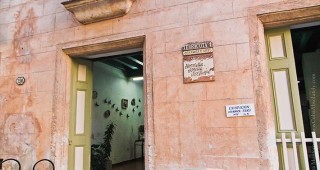This is the biggest of Cuba’s five synagogues and is considered one of the most important architectural works in the country. It has a hard-looking exterior with vertical lines that make reference to the yearning of the people of Israel to get close to God. Despite being very simple in design, with no exaggerated ornaments, its construction costs were of over half a million pesos in the 1950s. An aluminum Star of David and a monumental dome highlight the entrance to the building.

Unión Árabe de Cuba LH  1
1
This is the venue of the Unión Árabe de Cuba, which represents around 50,000 Arab descendants from all over the country. It has a small art gallery which features Arab-influenced art and ceramics.

Solimar Building LH  1
1
An interesting and typical example of the Streamline movement which preferred rounded corners and a sensation of motion can be seen in this building built in 1944. The recovery of simple forms and the …
 Art DecoSoledad esquina a San Lázaro
Art DecoSoledad esquina a San Lázaro 
Estación Central de Ferrocarriles LH  1
1
The building of the railway station, expression of the Spanish plateresque style, was built in 1912 on the site of the former Armory. It has four floors with 77 windows and the main entrance is rounde …
 EclecticAdmission: FreeEgido esq. a Arsenal, Habana Vieja
EclecticAdmission: FreeEgido esq. a Arsenal, Habana Vieja 
Terracota 4 LH  1
1
This is the studio-gallery of ceramicists Amelia Carballo and Ángel Norniella. Their work shows a wide variety of influences and techniques, including the millenary raku, and as the name suggests focu …

Memorial a Julio Antonio Mella LH  1
1
Across from the Universidad de La Habana is this memorial, often used to make concerts and for political or student rallies. It holds the ashes of Julio Antonio Mella, a young student leader and found …

Palacio del Segundo Cabo
In 1770 the Spanish Crown decided to construct a building next to the Castillo de la Real Fuerza on the north side of the Plaza de Armas to serve as the Royal Post Office, responsible for all postal c …
 BaroqueAdmission: n-aO’Reilly #4, esq. a Cuba, Habana Vieja
BaroqueAdmission: n-aO’Reilly #4, esq. a Cuba, Habana Vieja 




